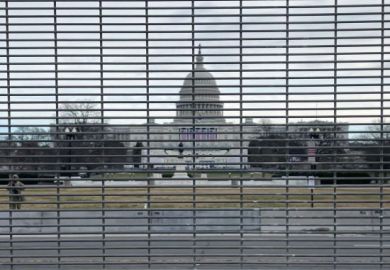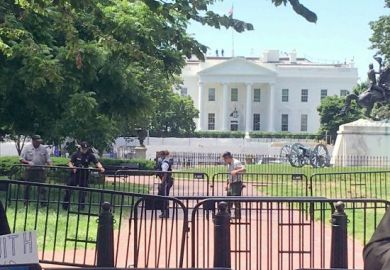The Biden administration is more than doubling the number of borrowers eligible for forgiveness of their federal student loan debt, calling it a critical act of equity. More quietly, however, it is further backtracking on Joe Biden’s campaign promise of far more sweeping relief.
Among its latest strikes against the $1.7 trillion (£1.2 trillion) pile of student loan debt held by an estimated 43 million Americans, the administration announced that it would discharge $5.8 billion owed by 323,000 people with total and permanent disabilities. “This is in alignment with our strategies from day one to put our borrowers at the centre of the conversation” in higher education, Miguel Cardona, the US secretary of education, declared.
That brought the administration’s total student loan write-offs to $8.7 billion and 455,000 borrowers, with previous rounds also involving limited circumstances such as disabilities and fraud by for-profit institutions.
Shortly after that move, Biden officials announced plans to award full student-debt relief to borrowers defrauded by for-profit institutions, a reversal of the Trump administration policy of granting limited if any forgiveness. The Biden team said it had no immediate estimate of the cost of that decision.
Mr Biden, however, is still hesitating on his campaign promise to forgive at least $10,000 per person in federal student loans, owing to both uncertainty over his legal rights to do so without congressional approval and wide divides within his own party over the wisdom of such a move.
Dr Cardona baulked when asked for the status of the president’s broader loan forgiveness pledge. “That process is still under way,” he told Times Higher Education at a briefing on the disabilities-related expansion, without elaborating.
And a top departmental aide, Ben Miller, further dampened prospects by describing the administration as concentrating on drafting regulatory changes that would give it “targeted loan cancellation” authority.
Mr Biden repeatedly promised the $10,000-per-person cancellation during his presidential campaign and afterward. The idea carried political appeal because it would cost taxpayers less than a quarter of the $1.7 trillion total debt while freeing more than a third of all borrowers from any further obligations, helping them to move ahead with buying homes and starting families.
But even his progressive backers, and independent analysts, cannot agree on its ultimate value to the economy. And there is even less study on the potential effect of widespread student loan forgiveness on the long-term conditions for colleges and universities.
Chief advocates of universal student loan forgiveness include Elizabeth Warren, a senator from Massachusetts and a 2020 presidential contender who backs $50,000 per person in debt cancellation, plus various groups and leaders within minority communities who feel that student debts are stifling the growth of the black middle class.
Yet others in Democratic circles − as well as many Republicans − have raised concerns that unilateral student loan forgiveness might benefit large numbers of wealthier Americans and create chaotic uncertainties in the federal loan programme in the future.
That split grew wider in recent weeks when the top Democrat in Congress, Nancy Pelosi, the speaker of the House of Representatives, said Mr Biden lacked the legal authority to cancel student loan debt on his own and suggested that it was also a bad idea politically. Yet the Senate’s Democratic leader, Chuck Schumer, has been a vocal supporter of forgiving $50,000 per borrower.
Experts who study the question have their own divisions. Sceptics of broad student loan forgiveness include the left-leaning Urban Institute, which sees the idea as having regressive elements, given that it treats struggling lower-income borrowers no better than those with graduate degrees and high incomes.
The centre-left thinktank Third Way takes a similar view, seeing universal debt cancellation plans as carrying a “massive price tag that benefits upper-income Americans the most”.
Those on the other side include the liberal Roosevelt Institute, which acknowledges that wealthier borrowers might get money they do not need but regards such situations as limited. The average per-borrower benefit from an across-the-board $50,000 cancellation, according to the institute’s calculations, would exceed $17,000 per person among black households in the bottom 10 per cent of net worth and just $562 for people in the top 10 per cent of net worth.
Another assessment, by experts at the Levy Economics Institute of Bard College, said outright student debt cancellation by the federal government would give the economy a boost that would partially offset its cost, “with only moderate effects on the federal budget deficit, interest rates and inflation”.
The question of a president’s legal right to cancel student debt also creates fractures in professional assessments. There is, however, little dispute that it can be done in specific situations such as disability and fraud. And both Mr Biden and his predecessor, Donald Trump, have delayed all student loan payments and the accumulation of interest since early in the pandemic, citing the economic emergency.
Then there is the question of whether broad student loan forgiveness benefits universities themselves. It’s reasonable to expect that students might borrow even more after an act of broad debt forgiveness, said Robert Kelchen, a professor of educational leadership and policy studies at the University of Tennessee-Knoxville.
But that might lead to additional responses with counteracting effects, including Congress acting to limit borrowing, Professor Kelchen said. “I don’t think there is good research on the potential longer-term effects” on higher education overall, he said.
Jason Jabbari, an assistant research professor of social work at Washington University in St Louis, shares that impression. Professor Jabbari heads the education research portfolio at the university’s Social Policy Institute, which has found that debt forgiveness would likely lead some debt holders to return to study.
But, Professor Jabbari acknowledged, “there simply isn’t a ton of research on what this means for institutions”.
For all the uncertainties surrounding student loan forgiveness, there are some areas of strong agreement. One is that a vastly disproportionate share of the debt problem is linked to for-profit institutions. Another is that borrowers are in especially bad shape if they spent money on higher studies but left without a degree. That has put a spotlight on the importance of universities doing more to help struggling students find their way towards completion.
However, political ideologies loom as major obstacles. The American Council of Trustees and Alumni, a right-wing entity that aims to advise institutional governing boards, recently issued a report that blames student debt on escalating tuition fees attributable to excessive spending on non-instructional staff.
Yet Armand Alacbay, the group’s vice-president of trustee and government affairs, acknowledged the major debt problems associated with students failing to finish their studies, and agreed that institutions might need to assign staff to help them.
“If anything,” he said of the so-called completion crisis, “this underscores the need for trustees who know their institution best to make sure” that money is being spent in the right places.
That level of nuance is not necessarily coming through to lawmakers, however.
Ted Cruz, a Republican senator from Texas, said at a recent hearing on student loan bankruptcy that the cost of higher education was now 31 times greater than it was in 1970. The 2016 US presidential candidate claimed that the causes were illustrated by the example of the University of Michigan, which “has 163 diversity and inclusion employees”.
That, said Mr Cruz − echoing the conservative Heritage Foundation − amounts to 2.3 such employees for every one member of Michigan’s history faculty. “Our universities don’t teach any more,” the senator said. “They are instead paid sinecures for people who go and work for the government.”
The university rejected the characterisation. “The single biggest reason for increasing tuition [costs] at the University of Michigan is the dramatic decline in state support for higher education”, which is down from 64 per cent of the general fund budget in 1970 to 14 per cent now, Rick Fitzgerald, a university spokesman, said.
Despite the divisions in Congress, the US public appears generally supportive of the idea of writing off some student debt. A new Axios/Ipsos poll of nearly 2,000 Americans found 55 per cent support forgiving all federal student loan debt, and 59 per cent approve making four-year colleges free to any US citizen.
Individual institutions are also voting for student loan forgiveness. South Carolina State University, Delaware State University, Dallas College and Wilberforce University are among the campuses that have used millions of dollars in federal Covid relief to eliminate debts for thousands of their students.
But while the need for political cover and simplicity may create an argument for universal forgiveness, a range of policy experts continue to advocate more targeted strategies.
The Third Way and the Brookings Institution are among many that support simply limiting the number of beneficiaries to those who need it most. The Urban Institute suggests accomplishing the same basic goal by retroactively doubling payments through the Pell grant programme, the main federal subsidy for low-income students.
Constantine Yannelis, an assistant professor of finance at the University of Chicago, also regards broad student loan forgiveness as regressive but concedes the difficulties in crafting more precise options that will work for the long term.
Solutions that do not create yet more problems could involve giving colleges and universities “skin in the game”, so they have greater incentives to improve student performance and keep costs down, Professor Yannelis said.
One example worth more study is Brazil, he said, which also had a problem with for-profit institutions abusing student loan programmes: it created a system that charged institutions for any borrowers who later dropped out.
The US government does have its own system that reduces loan payments for low-income borrowers and forgives their balances entirely after 20 years. That also looks promising, Professor Yannelis said, but it began only in 2008 and therefore does not have enough of a track record to fully evaluate.
He did, however, emphasise the importance of a long-term strategy that encourages positive behaviours by all actors.
“The big problem in higher education is that incentives aren’t aligned between schools, borrowers and the government,” he said. “If we don’t fix the underlying incentive problems, we’re going to end up in the exact same spot and we’ll be having the exact same discussion in the future.”
POSTSCRIPT:
Print headline: Biden cancels more student debt but holds on bigger fixes
Register to continue
Why register?
- Registration is free and only takes a moment
- Once registered, you can read 3 articles a month
- Sign up for our newsletter
Subscribe
Or subscribe for unlimited access to:
- Unlimited access to news, views, insights & reviews
- Digital editions
- Digital access to THE’s university and college rankings analysis
Already registered or a current subscriber?







